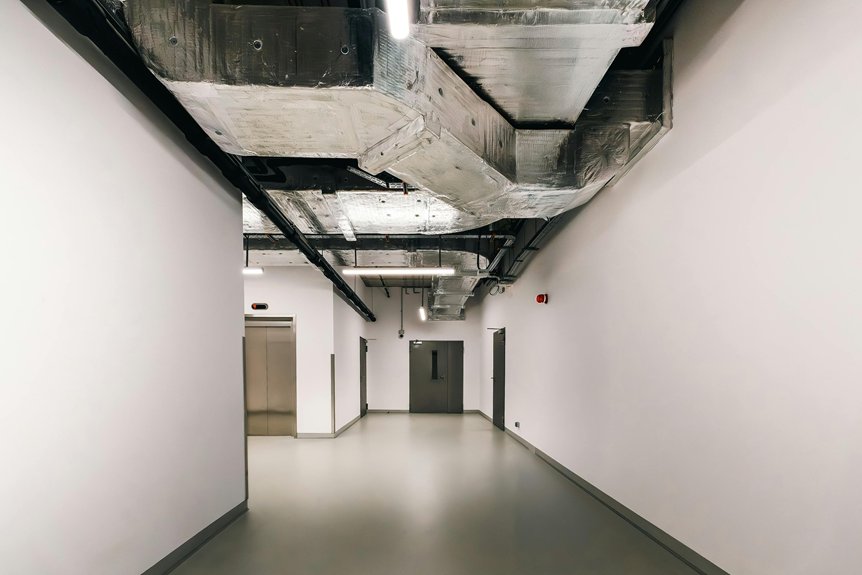Heating and air conditioning systems have developed significantly from the ancient Roman hypocausts to contemporary energy-efficient solutions. Today’s HVAC systems prioritise sustainability, incorporating advanced technologies such as heat pumps, high-efficiency refrigerants, and smart thermostats to minimise energy consumption.
There is a noticeable trend towards eco-friendly and cost-effective options, driven by urbanisation and more stringent regulations. As innovative systems continue to emerge, understanding these advancements empowers consumers to make informed decisions.
As we delve deeper, we uncover even more about the future of climate control and the importance of selecting the right solutions for both comfort and the environment.
The Evolution of HVAC Technologies
The evolution of HVAC technologies reveals a rich history of innovation driven by the necessity for improved heating, cooling, and environmental control. The ancient Romans employed hypocaust systems, circulating warm air beneath floors to heat their buildings effectively.
During the 19th century, steam-powered systems facilitated centralised heating, while mechanical methods using blocks of ice began to introduce cooling processes. Coal stoves provided warmth in homes, and steam radiators became commonplace during the Industrial Revolution.
The invention of the first modern air conditioning system by Willis Carrier marked a significant milestone in HVAC development. Originally designed to regulate humidity in a printing plant, this breakthrough laid the groundwork for contemporary heating, ventilation, and air conditioning systems.
Following the Second World War, central heating systems gained widespread popularity, and the affordability of residential air conditioning increased significantly in the mid-20th century. Carrier’s invention revolutionized indoor climate control and set the stage for today’s sophisticated systems.
Today, advancements in HVAC technology emphasise energy efficiency, the use of environmentally friendly refrigerants, and the integration of smart, automated systems.
As we move forward, the focus remains on creating sustainable solutions for indoor climate control that enhance comfort while minimising environmental impact.
Market Trends Shaping Heating and Cooling Solutions
The growing demand for more efficient and environmentally friendly heating and cooling solutions is shaping market trends across the UK.
The HVAC sector is experiencing significant expansion, driven by the need for sustainable systems that reduce energy consumption and carbon footprints.
Electrification is central to this evolution, with heat pumps, particularly Variable Refrigerant Flow (VRF) systems, becoming increasingly popular due to their energy efficiency and capability to operate across multiple zones.
Regulatory frameworks are encouraging a transition to low Global Warming Potential (GWP) refrigerants, resulting in a surge of retrofits and replacements of older systems that are less compliant with modern standards.
Additionally, rising urbanisation and heightened expectations for indoor comfort are contributing to market growth, particularly within commercial environments.
The increasing adoption of smart, connected systems is also noteworthy, as these technologies enable users to optimise energy usage and enhance comfort while aligning with environmental objectives.
Energy-efficient HVAC solutions are also gaining ground, driven by consumer awareness and government incentives aimed at reducing overall carbon emissions.
As the HVAC landscape continues to evolve, staying informed about these trends is essential for businesses and consumers alike.
Energy Efficiency and Sustainability in HVAC Systems
As the demand for sustainable heating and cooling continues to rise, enhancing energy efficiency in HVAC systems has become a key priority for both manufacturers and consumers in the UK.
Modern systems are now required to meet a minimum SEER2 rating of 15 in many regions, with top-rated models achieving impressive levels of efficiency. Upgrading to high-efficiency systems can significantly reduce household energy consumption, leading to cost savings and a lower environmental footprint.
Key developments in this field include:
- Advanced technology, such as high-efficiency heat pumps and variable speed compressors, enhances overall performance.
- IoT devices and smart thermostats enable real-time optimisation of HVAC operation, contributing to notable energy cost savings.
- The introduction of new refrigerants with lower global warming potential, like R-454B and R-32, supports environmentally friendly transitions, helping to reduce emissions.
According to recent industry reports, these advancements can also facilitate compliance with increasingly stringent environmental regulations. With these advancements, consumers can make informed choices that not only benefit their homes but also contribute to a more sustainable future.
Navigating Workforce Challenges in the HVAC Industry
Addressing workforce challenges in the HVAC industry in the UK involves tackling a range of complex issues. The industry is facing a significant shortage of technicians, with many approaching retirement. This situation impacts the future labour supply and underlines the urgent need to attract new talent. The HVAC workforce in the UK is projected to grow by 9% from 2021 to 2033, reflecting the industry’s increasing demand for skilled workers. Currently, women represent only a small fraction of the workforce, and minorities are underrepresented, which limits diversity and growth within the sector. The HVAC industry is expanding at a pace faster than average, creating numerous new job opportunities each year, particularly in regions such as the South East and the North West. However, barriers such as limited awareness of skilled trades and gaps in training hinder workforce development. Efforts to include more women and minorities, along with the adoption of modern technology, are essential for building a stronger and more diverse HVAC community.
Conclusion
Advancements in HVAC technology continue to enhance energy efficiency and sustainability, influenced by market trends and environmental concerns. As systems become more intelligent and eco-friendly, the industry encounters persistent workforce challenges that necessitate strategic solutions.
Staying informed about these developments empowers consumers to make educated decisions and ensures that the industry evolves in response to future demands.
The progression of heating and cooling systems is aimed at creating comfortable environments while minimising environmental impact. This underscores the significance of innovation and skilled professionals within this essential sector.

